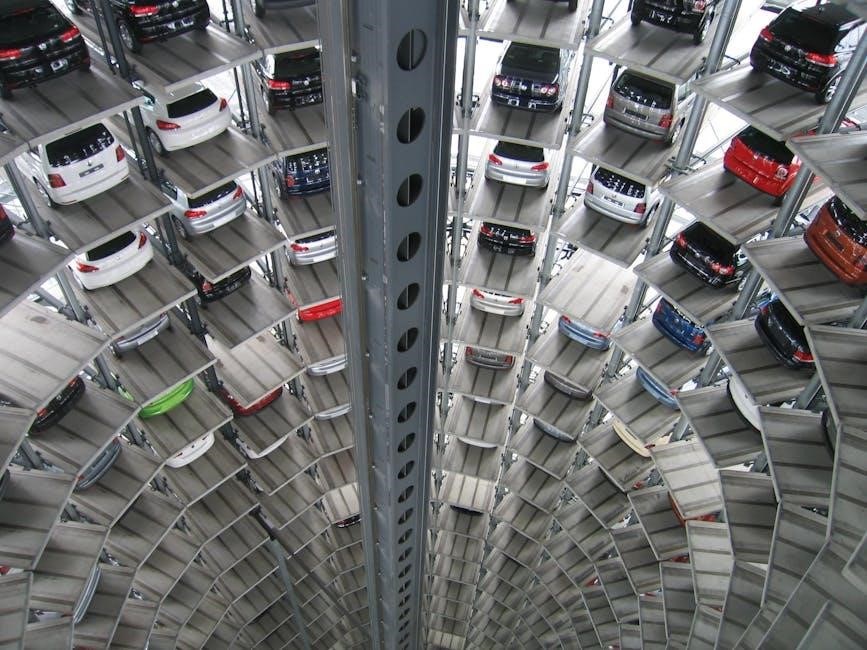rocket mass heater plans pdf
Rocket Mass Heater Plans offer comprehensive guides for building efficient, sustainable heating systems. Detailed PDFs include materials lists, step-by-step instructions, and high-resolution images for DIY enthusiasts.
What is a Rocket Mass Heater?
A Rocket Mass Heater (RMH) is a highly efficient, sustainable heating system combining a rocket stove and masonry heater. It uses an insulated burn chamber and J-tube design to ensure complete combustion, significantly reducing fuel consumption. Unlike traditional wood stoves, RMHs store heat in a thermal mass, providing long-lasting warmth with minimal wood usage. This innovative design maximizes heat output while minimizing emissions, making it an eco-friendly alternative for home heating. The system is ideal for off-grid living, offering both cost-effectiveness and environmental benefits. Its compact size and versatile design allow it to heat spaces efficiently, making it a popular choice for eco-conscious homeowners and builders.
History and Evolution of Rocket Mass Heaters
The Rocket Mass Heater (RMH) traces its roots to the 1980s, evolving from traditional rocket stoves and masonry heaters. Pioneers like Ianto Evans and Leslie Jackson refined the concept, emphasizing efficiency and sustainability. Early designs focused on simple, low-cost materials, while modern versions incorporate advanced insulation and thermal mass strategies. Over the years, the RMH has grown in popularity, with enthusiasts and engineers improving designs for better performance. Recent advancements include optimized combustion chambers, improved ducting systems, and customizable designs. Today, RMHs are celebrated for their eco-friendly, cost-effective heating solutions, supported by thriving online communities and detailed construction plans, making them accessible to DIY builders worldwide.
Importance of Detailed Plans and Designs
Detailed plans and designs are crucial for successfully building a Rocket Mass Heater. They provide clear, step-by-step instructions, ensuring safety and efficiency. These plans typically include material lists, dimensions, and construction sequences, minimizing errors. High-resolution images and 3D models help visualize complex components. Proper designs ensure complete combustion, optimal heat transfer, and durable construction. Without precise plans, builders risk inefficiencies, safety hazards, or structural failures. Trusted guides, like those from experienced builders, offer proven methods, making DIY projects achievable. Detailed plans also facilitate customization, allowing users to adapt designs to specific spaces or needs, ensuring effective and reliable heating systems.

Benefits of Rocket Mass Heaters
Rocket Mass Heaters offer exceptional efficiency, sustainability, and cost savings. They use less wood, reduce emissions, and provide long-lasting heat, making them an eco-friendly and economical heating solution.
Efficiency and Sustainability
Rocket Mass Heaters are renowned for their exceptional efficiency, achieving up to 90% fuel efficiency compared to traditional wood stoves. By ensuring complete combustion in an insulated chamber, they produce minimal emissions and require significantly less wood. This sustainable design reduces environmental impact while providing consistent heat. The system’s thermal mass absorbs and releases warmth slowly, maintaining a cozy environment with minimal fuel. Detailed plans in PDF formats often include eco-friendly materials and construction methods, making these heaters a greener alternative for home heating. Their innovative engineering ensures long-term sustainability, aligning with green building principles and self-sufficiency goals.
Cost-Effectiveness
Rocket Mass Heaters are highly cost-effective, offering significant savings on fuel and installation. By using locally sourced, natural materials like bricks, sand, and ceramic insulation, construction costs are minimized. The system’s efficient design reduces wood consumption by up to 90%, lowering operational expenses. Additionally, the long-lasting durability of these heaters ensures years of reliable service with minimal maintenance. DIY plans and guides, often available in PDF formats, empower homeowners to build their own systems, further reducing costs. This sustainable heating solution is both environmentally friendly and economically viable, making it an attractive option for those seeking to lower their energy bills and reliance on expensive heating systems.
Comfort and Versatility
Rocket Mass Heaters provide exceptional comfort through radiant heat, warming spaces evenly without the dryness of traditional systems. Their versatility allows installation in various settings, from small cottages to larger homes. Designs like pebble-style or brick-based heaters offer aesthetic flexibility, blending with different interiors. The thermal mass absorbs and releases heat slowly, ensuring prolonged warmth. These heaters can be customized to fit specific space requirements, making them adaptable to diverse living situations. Additionally, their ability to use small amounts of fuel efficiently enhances their practicality. Overall, Rocket Mass Heaters combine comfort, sustainability, and flexibility, making them a popular choice for eco-conscious homeowners seeking reliable and cozy heating solutions.

Design and Function of Rocket Mass Heaters
Rocket Mass Heaters combine a combustion chamber, insulated heat riser, and thermal mass to efficiently store and release heat, providing radiant warmth through innovative design.
Core Components
The core components of a rocket mass heater include the combustion chamber, heat riser, and thermal mass. The combustion chamber is where fuel burns efficiently, while the heat riser channels gases into the thermal mass, which absorbs and releases heat slowly. These components work together to maximize heat retention and minimize fuel use. Proper design and material selection are crucial for optimal performance and safety. Detailed plans often specify materials like ceramic fiber boards, red bricks, and stone for durability and thermal efficiency. Understanding these components is essential for constructing a reliable and efficient heating system.
Key Design Principles
Key design principles for rocket mass heaters focus on maximizing efficiency, safety, and durability. Proper insulation of the combustion chamber and heat riser ensures complete fuel combustion and minimizes heat loss. The system relies on precise airflow management to maintain a strong draft, essential for efficient burning. Thermal mass materials like brick or stone are used to absorb and release heat slowly, providing consistent warmth. The layout of ducting and the size of the heat riser are critical to ensure even heat distribution. Detailed plans often emphasize the importance of proportions and alignment to achieve optimal performance. Following these principles ensures a reliable, eco-friendly, and cost-effective heating solution.

Materials and Tools Needed
Ceramic fiber boards, red bricks, stone, and sheet metal are essential materials. Tools like a saw, trowel, and drill are required for construction, ensuring precision and safety.
List of Required Materials
The primary materials needed include high-temperature ceramic fiber boards, red bricks, and natural stone or concrete for the bench and bell tops. Additionally, sheet metal is required for the stovepipe and ducting system. Other essential components are insulation materials, fireproof mortar, and a steel barrel for the heat riser. Tools such as a saw, trowel, drill, and safety gear are also necessary. Detailed quantities and specifications are provided in the PDF plans to ensure accuracy and safety during construction. These materials are carefully selected to withstand high temperatures and ensure efficient combustion and heat retention, making the rocket mass heater both durable and effective.
Essential Tools for Construction
Constructing a rocket mass heater requires specific tools to ensure precision and safety. A saw or tile cutter is necessary for cutting bricks and ceramic fiber boards. A trowel and level are essential for laying bricks evenly and ensuring the structure is properly aligned. A drill with bits is needed for creating holes in metal components and mixing mortar. Heat-resistant gloves, safety goggles, and a dust mask are crucial for protecting oneself while handling materials. Additionally, a measuring tape, pencil, and scraper are useful for marking cuts and smoothing surfaces. These tools, along with basic masonry skills, enable the successful assembly of the heater’s core components and insulation system.

Safety Considerations
Ensure proper installation, ventilation, and material selection to avoid hazards. Protect surroundings from heat exposure and follow detailed plans to maintain safety during construction and operation.
Installation Guidelines
Proper installation is critical for safe and efficient operation of a rocket mass heater. Begin by selecting a suitable location, ensuring it is away from flammable materials. Follow the detailed plans to construct the core components accurately. Use high-temperature materials for the burn chamber and heat riser to prevent cracking. Install the chimney with adequate clearance, ensuring it meets local building codes. Connect the ducting system carefully, avoiding sharp bends that could restrict airflow. Test the system thoroughly before regular use to ensure proper draft and heat distribution. Always refer to the PDF guide for specific instructions.
Operational Safety Tips
Ensure safe operation by keeping flammable materials at least 3 feet away from the heater. Always use properly seasoned, dry wood to maintain efficient combustion. Avoid overloading the firebox, as this can lead to incomplete burning and potential hazards. Regularly inspect the chimney and ducting for blockages or damage. Use a thermometer to monitor temperatures, especially in the heat riser, to prevent overheating. Keep children and pets away from the heater while in operation. Maintain good ventilation in the room to prevent carbon monoxide buildup. Refer to the PDF guide for specific safety recommendations tailored to your design.

Step-by-Step Construction Plans
PDF guides provide detailed, step-by-step instructions for building rocket mass heaters, including materials lists, layer-by-layer brick layouts, and 3D models for visual guidance during construction.
Preparation and Planning
Preparation is crucial for a successful rocket mass heater project. Begin by gathering all necessary materials, such as ceramic fiber boards, red bricks, and sheet metal, as outlined in the PDF plans. Assess the space to ensure proper sizing and layout, considering factors like the area to be heated and ducting requirements. The footprint of the heater, typically around 7×10 feet, and duct lengths of 25 feet with bends, should align with your space. Plan the layout to optimize heat distribution and efficiency. Safety protocols, such as proper ventilation and insulation, must be integrated into the design. Consult the detailed guides for specific measurements and configurations to ensure a safe and functional system. Adherence to the plans is key to achieving the desired performance and safety standards.
Building the Core Components
Constructing the core components of a rocket mass heater requires precision and adherence to the PDF plans. Start by assembling the insulated J-tube, ensuring a tight fit to promote complete combustion. The steel barrel serves as the heat riser, directing gases into the ducting system. Use high-temperature insulation materials like ceramic fiber boards to line the combustion chamber and riser, enhancing efficiency. Properly stack bricks or stones to form the mass around the ducting, allowing for heat absorption and storage. Follow layer-by-layer instructions from the guide to ensure structural integrity. The core components must be built to withstand high temperatures while maintaining airflow and heat transfer efficiency, as detailed in the plans.
Insulation and Ducting
Proper insulation and ducting are critical for maximizing the efficiency of a rocket mass heater. Use high-temperature insulation materials like ceramic fiber boards or vermiculite to line the combustion chamber and riser, ensuring minimal heat loss. The ducting system, typically made from durable materials such as metal or clay pipes, should be carefully routed through the mass to distribute heat evenly. The PDF plans provide detailed diagrams for laying out the ductwork, including optimal lengths and bends to minimize resistance. Insulation around the ducts and mass ensures that heat is absorbed and stored effectively, allowing for prolonged warmth. Proper installation of these components is essential for safe and efficient operation.
Finishing Touches
Finishing touches are essential for completing a rocket mass heater. Once the core components and ducting are in place, apply a breathable plaster or finish, such as lime or gypsum, to protect the exterior while allowing heat to radiate evenly. For aesthetic appeal, consider adding tile, brick, or stone surfaces. Ensure all joints and gaps are sealed to maintain efficiency and safety. The PDF plans often include tips for blending the heater into your home’s decor. Final inspections and testing are crucial to ensure proper function and safety. These steps transform the heater into a functional, attractive, and long-lasting heating solution for your space.

Advanced Techniques for Optimization
Advanced techniques in rocket mass heater plans include optimizing efficiency through improved insulation, customized designs, and material upgrades. PDF guides provide detailed methods for enhancing performance and ensuring optimal heating results.
Enhancing Efficiency
Enhancing efficiency in rocket mass heaters involves optimizing combustion and heat retention. Detailed PDF plans often include strategies like insulating the burn chamber, ensuring proper airflow, and using high-quality materials. These methods minimize fuel consumption while maximizing heat output. Additionally, designs may incorporate features such as thermal mass storage, which absorbs and releases heat over time, improving overall efficiency. By following these advanced techniques, users can achieve significant reductions in wood usage, making the system more sustainable and cost-effective. Proper construction and maintenance, as outlined in the plans, are crucial for achieving these efficiency gains and ensuring reliable performance over the long term.
Customizing Your Heater
Customizing your rocket mass heater allows you to tailor its design to fit your space and needs. Plans often include options for varying materials, such as brick, stone, or cob, enabling aesthetic and functional adaptations. You can design the thermal mass to include benches, floors, or walls, maximizing heat retention and distribution. Some designs incorporate decorative elements or additional features like cooktops or boilers for further versatility. By adjusting dimensions, ducting, and insulation, you can optimize performance for specific spaces. PDF guides provide detailed instructions for customization, ensuring your heater is both efficient and personalized. This flexibility makes rocket mass heaters adaptable to diverse lifestyles and environments while maintaining their core efficiency and sustainability benefits.

Troubleshooting Common Issues
Address common problems like poor draft, insufficient heat, or improper combustion by adjusting chimney height, ensuring proper insulation, and using dry fuel for optimal performance.
Identifying and Solving Problems
Common issues with Rocket Mass Heaters include poor draft, low heat output, or incomplete combustion. These problems often stem from improper installation or design flaws. To address draft issues, ensure the chimney is tall enough and free of obstructions. For low heat output, check insulation quality and verify that the burn chamber is functioning correctly. Incomplete combustion can be resolved by ensuring adequate airflow and using dry, well-seasoned fuel. Refer to detailed PDF plans for troubleshooting guides and step-by-step solutions. Regular maintenance, such as cleaning the chimney and inspecting ducts, can prevent many issues. Always follow safety guidelines to maintain efficiency and safety.
Maintenance Tips
Regular maintenance is crucial for optimal performance and safety of Rocket Mass Heaters. Annual inspections of the chimney and ducts ensure proper airflow and prevent blockages. Clean soot and creosote buildup from the burn chamber and heat riser to maintain efficiency. Inspect bricks and mortar for cracks, addressing repairs promptly. Ensure all connections are secure and airtight. Store fuel in a dry, well-ventilated area to prevent moisture issues. Follow PDF guides for detailed maintenance schedules and procedures. Regularly check the system’s performance during heating season to identify potential issues early. Proper upkeep extends the lifespan of the heater and ensures reliable, efficient, and safe operation year-round.

Environmental Impact
Rocket Mass Heaters minimize environmental impact by reducing fuel consumption and emissions. They promote sustainable heating with efficient combustion and use eco-friendly materials.
Eco-Friendly Heating
Rocket Mass Heaters are a sustainable heating solution, offering eco-friendly performance by reducing fuel consumption and emissions. They achieve efficient combustion, minimizing environmental impact and lowering carbon footprints. Using locally sourced, natural materials like cob, brick, and recycled metal, these heaters align with green building practices. The designs often incorporate thermal mass storage, allowing for passive heating and reduced energy demand. By optimizing wood burning efficiency, Rocket Mass Heaters produce fewer pollutants compared to traditional stoves. Their eco-friendly nature makes them ideal for off-grid living, promoting renewable energy use and reducing reliance on fossil fuels. This sustainable approach ensures cleaner, greener heating for homes.
Reducing Carbon Footprint
Rocket Mass Heaters significantly reduce carbon footprints by minimizing fuel consumption and emissions. Their efficient design ensures complete combustion, producing fewer pollutants compared to traditional heating systems. By using up to 70-90% less wood, these heaters drastically lower carbon emissions. The incorporation of natural, locally sourced materials like cob and brick further enhances their eco-friendly profile. Additionally, the thermal mass storage component reduces energy demand by retaining and releasing heat over time. This sustainable approach not only lessens reliance on fossil fuels but also promotes renewable energy use, making Rocket Mass Heaters an ideal choice for those seeking to lower their environmental impact while enjoying reliable heat.

Community and Resources
Online forums, communities, and resources like the Rocket Mass Heater Jamboree offer extensive support. PDF guides, videos, and builder experiences provide valuable insights for successful DIY projects.
Online Communities and Forums
Online communities like the Rocket Mass Heater Jamboree and forums dedicated to sustainable heating offer extensive support and resources. These platforms provide access to detailed guides, step-by-step instructions, and high-resolution images. Builders share their experiences, tips, and troubleshooting advice, creating a collaborative environment for enthusiasts. Many forums feature downloadable PDF plans, such as the 6-inch rocket mass heater plans, which include layer-by-layer brick layouts and materials lists. These resources empower individuals to construct efficient and eco-friendly heating systems, fostering a sense of community among DIY enthusiasts. The wealth of information available helps ensure successful projects and encourages innovation in sustainable heating solutions.
Recommended Reading and Viewing
For a deeper understanding of rocket mass heaters, several resources are highly recommended. The Rocket Mass Heater Plans PDF offers detailed blueprints and step-by-step instructions, perfect for DIY enthusiasts. Additionally, the Free Heat movie and accompanying guides provide visual and practical insights into building efficient heaters. Erica Wisner and Ernie Wisner’s publications are also excellent, offering comprehensive guides and expert tips. Online forums and YouTube channels dedicated to sustainable heating showcase real-world applications and troubleshooting. These resources collectively provide a wealth of knowledge, ensuring builders have the tools and confidence to create eco-friendly, cost-effective heating solutions tailored to their needs.
Rocket mass heater plans offer a sustainable, efficient, and cost-effective heating solution. With detailed guides and resources, builders can create eco-friendly systems, embracing a warmer, greener future.
Final Thoughts
Rocket mass heater plans provide a pathway to sustainable, efficient, and cost-effective heating solutions. By leveraging detailed guides and resources, enthusiasts can construct eco-friendly systems that reduce fuel consumption and environmental impact. These designs emphasize completeness of combustion, superior insulation, and innovative materials, making them up to eight times more efficient than traditional stoves. With step-by-step instructions, high-resolution photos, and customizable options, builders of all skill levels can create functional and aesthetically pleasing heaters. Embracing this technology not only saves resources but also fosters a deeper connection to sustainable living. The sense of accomplishment from building your own heater is unmatched, making it a rewarding project for anyone committed to eco-conscious practices.
Encouragement to Build
Embarking on a rocket mass heater project is a rewarding journey that combines sustainability with practicality. With detailed PDF plans and guides readily available, even those new to DIY projects can successfully build an efficient heating system. The sense of accomplishment from creating a eco-friendly heater that reduces wood consumption and lowers energy costs is immense. Join a growing community of enthusiasts who have already embraced this innovative technology. Whether for a cozy cottage or a larger space, building a rocket mass heater is a step toward self-sufficiency and a greener future. Take the leap and start your project today!
